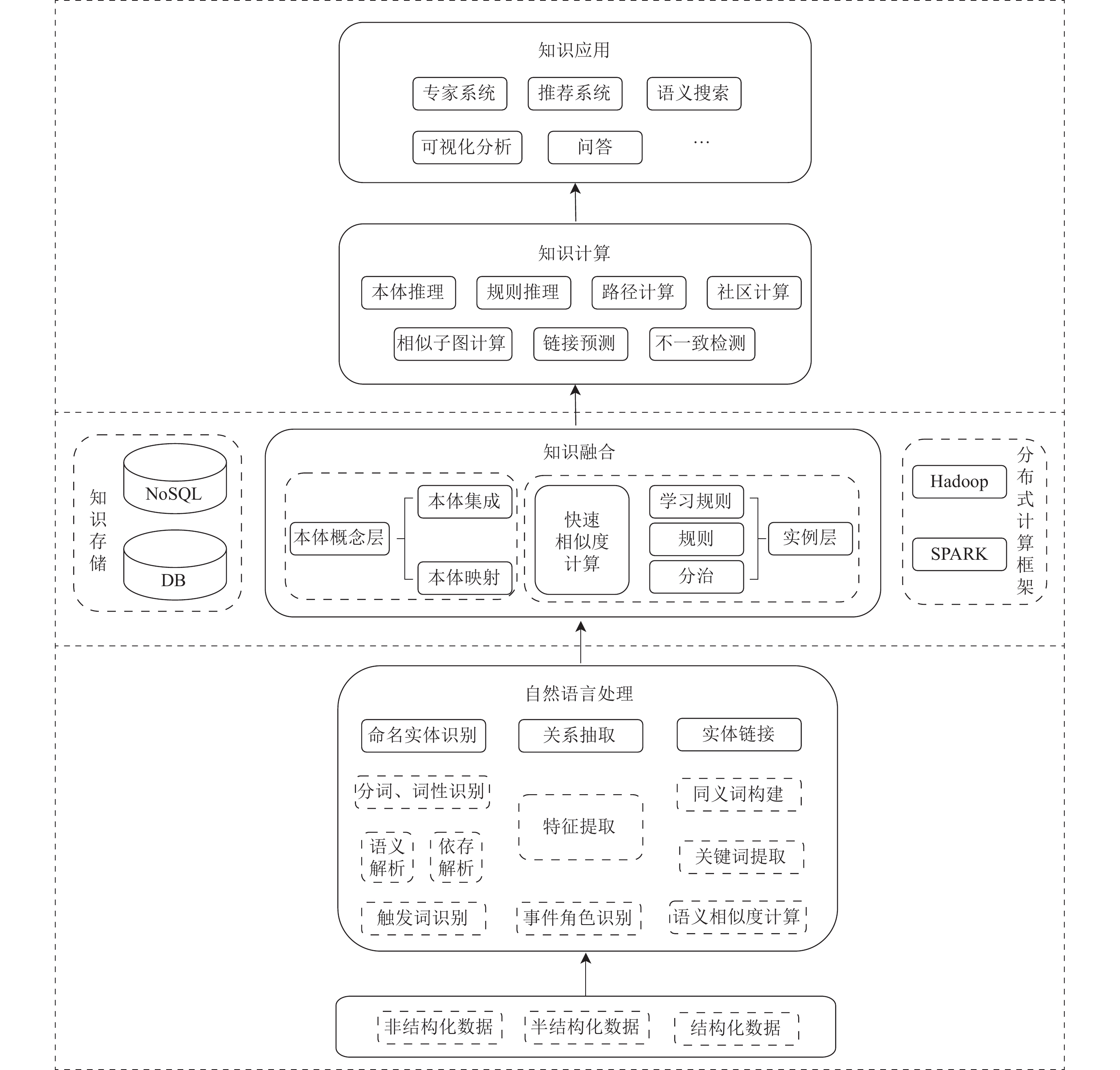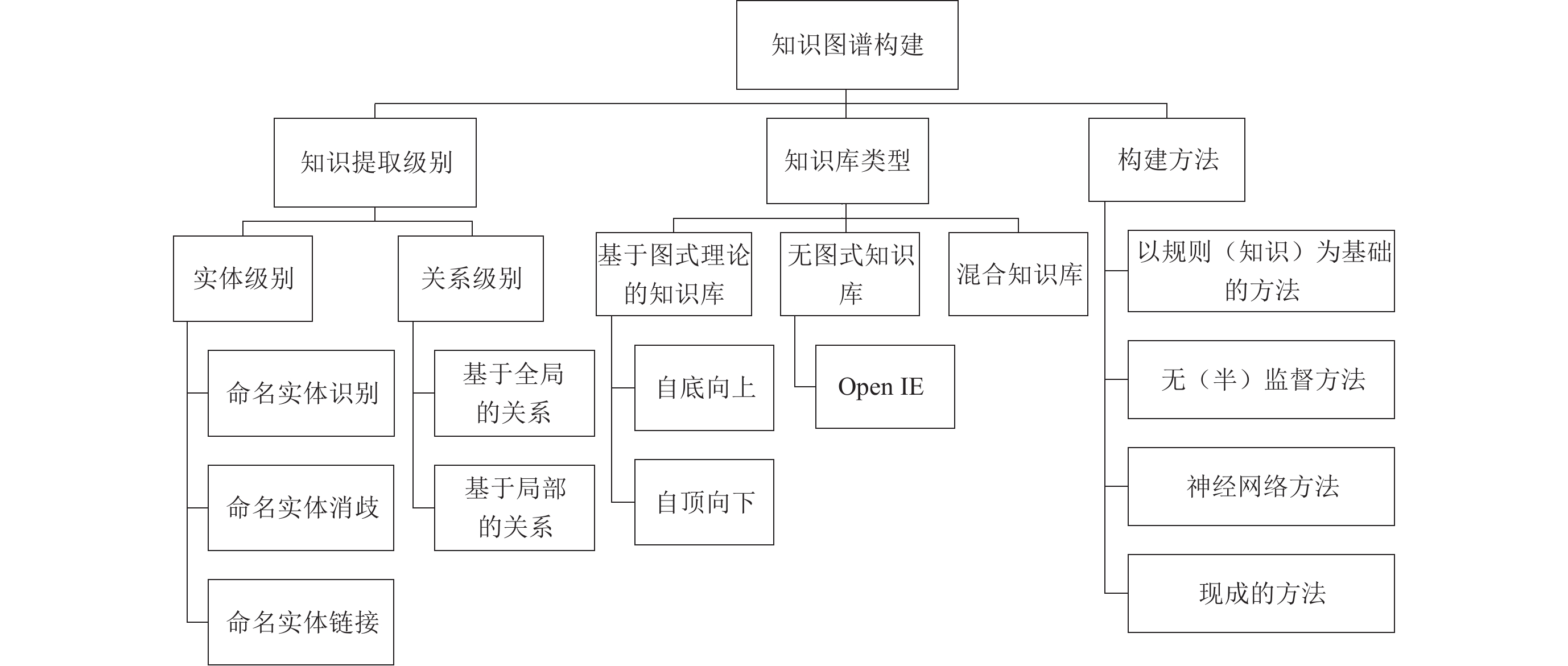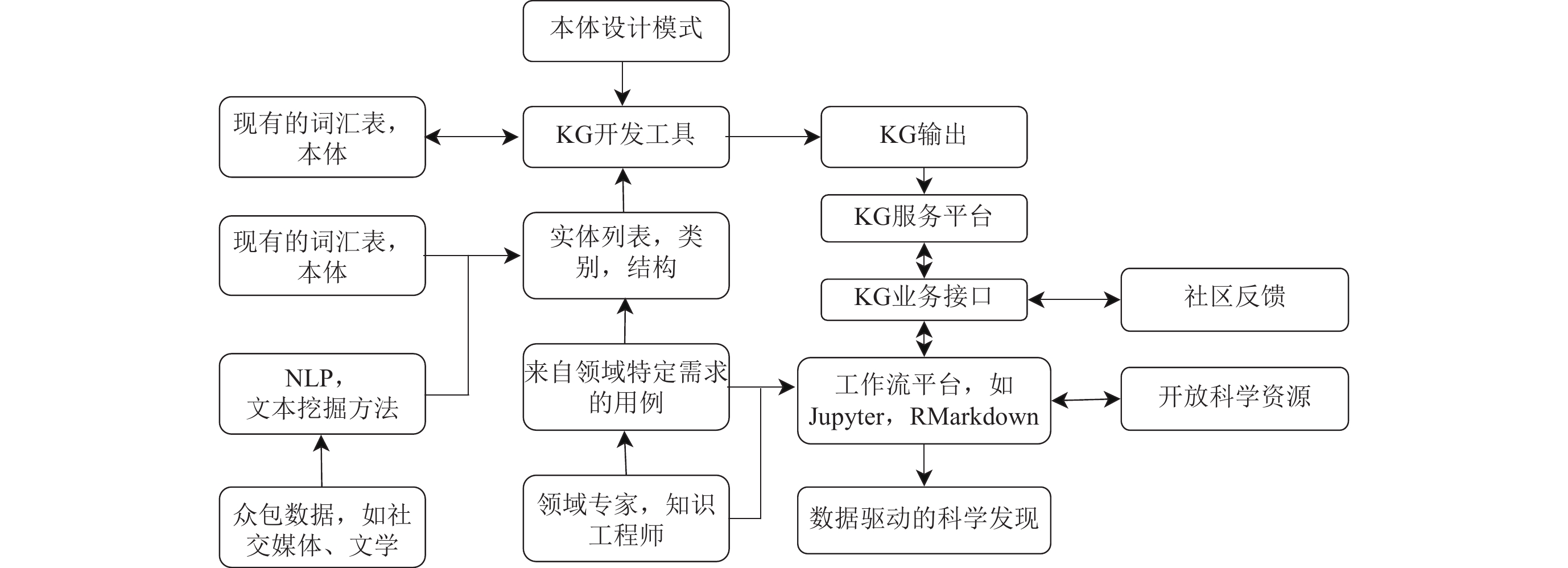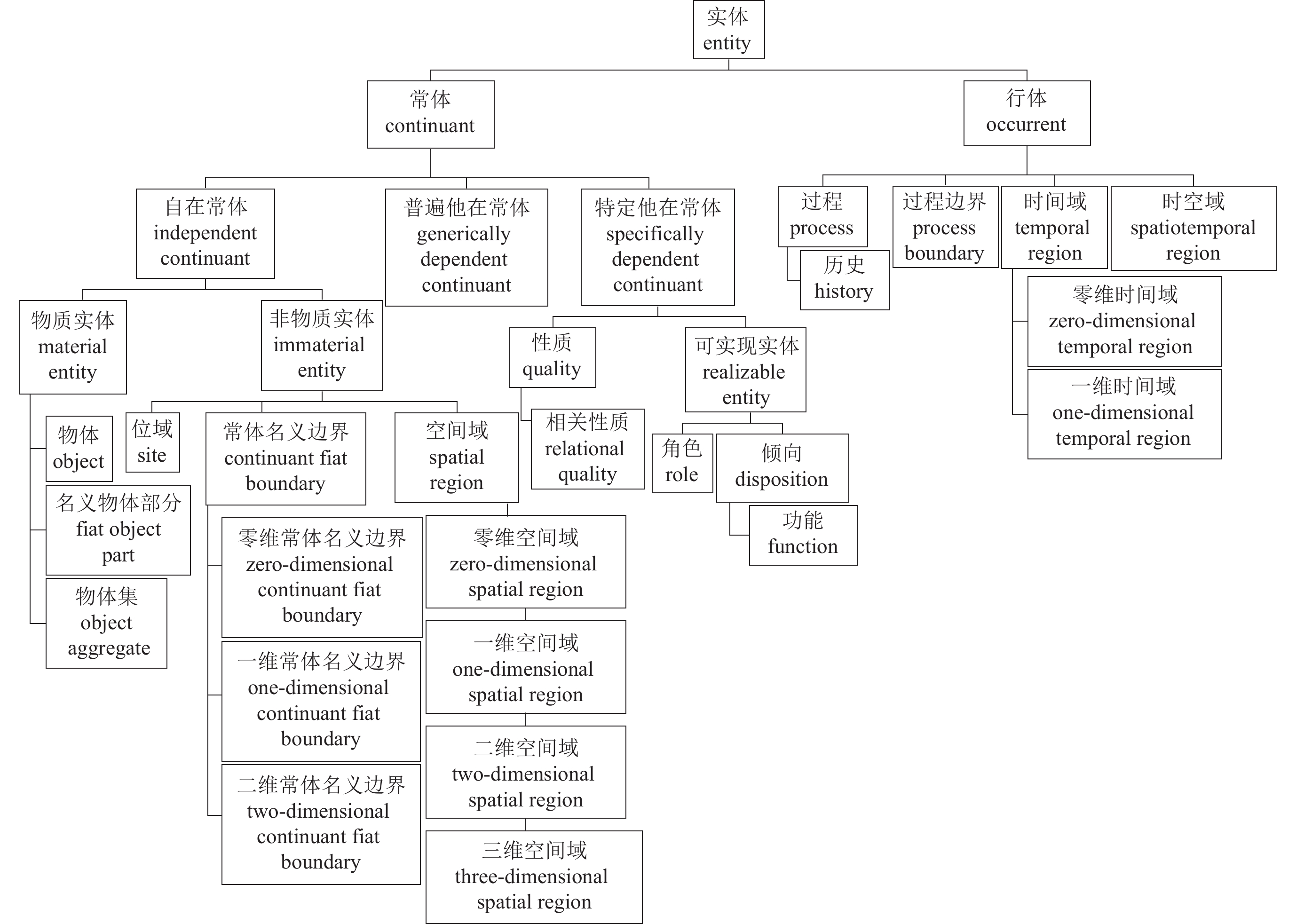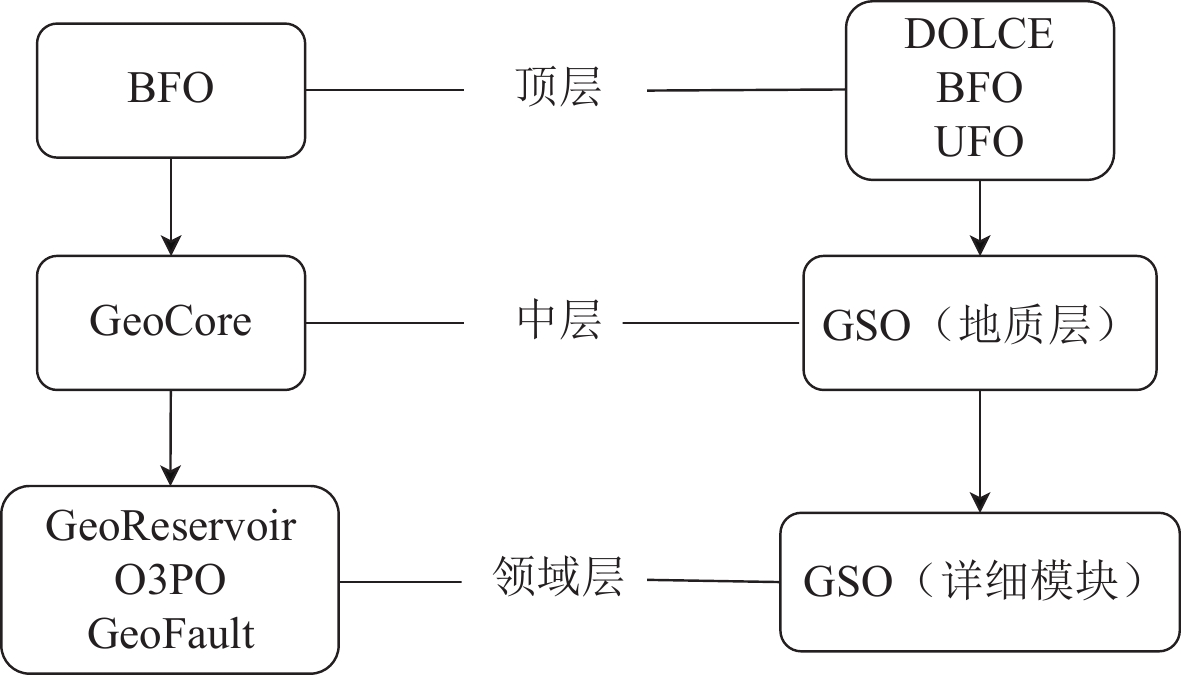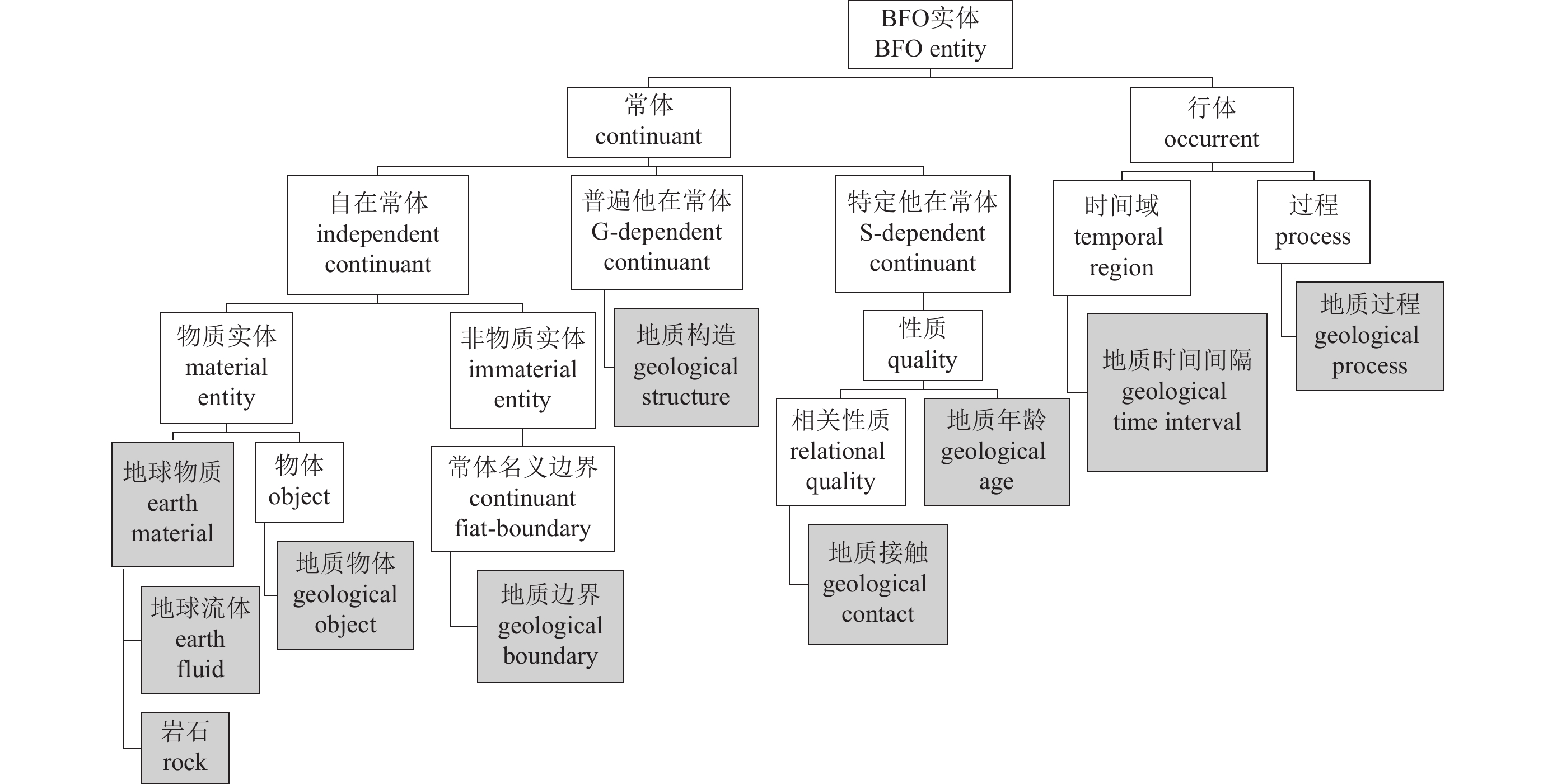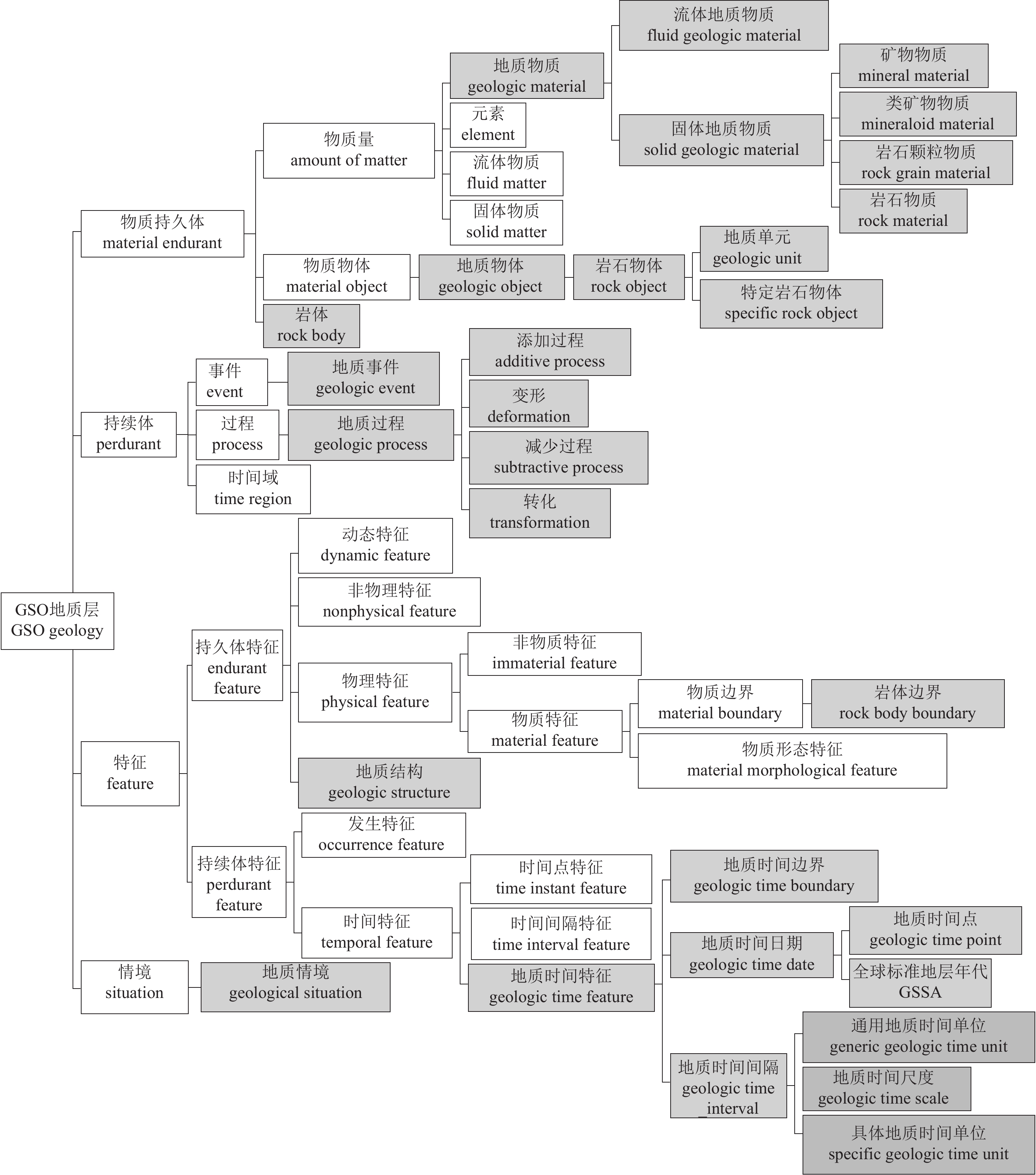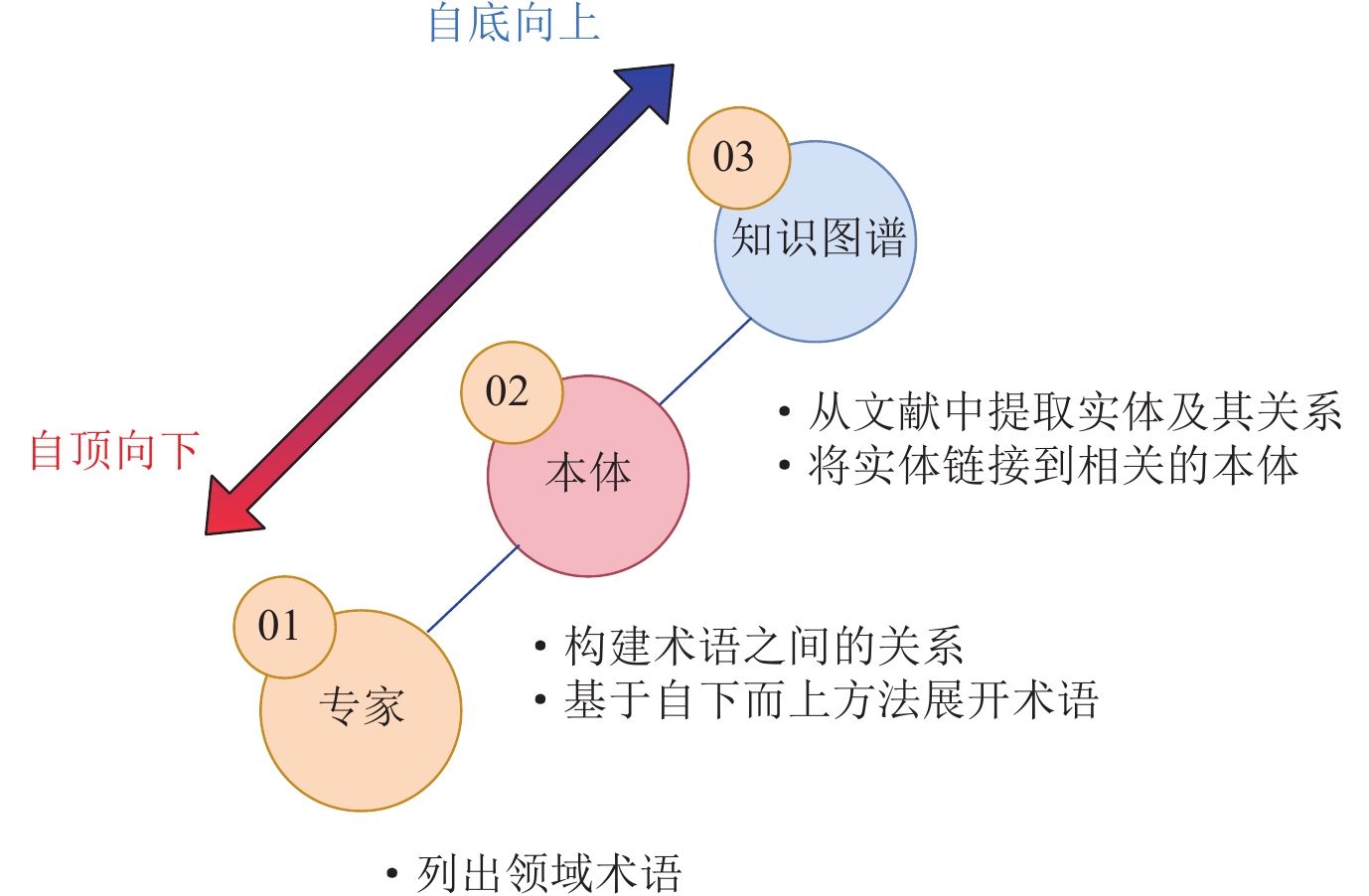Review and perspective of Earth Science Knowledge Graph in Big Data Era
-
摘要:
地球科学是一门数据密集型学科,而知识图谱则被认为是充分利用和发挥地球科学领域庞大数据的一种有效方式。相对于通用大模型技术的发展,知识图谱能提供更为准确的知识,增强生成式大模型结果的智能性和可靠性。本文首先阐释了知识图谱的相关概念和构建方法;然后,对在科学领域广泛应用的顶层本体基本形式化本体模型进行了详细介绍,简单总结了地球科学领域已经建成的知识图谱,并着重论述了地球科学领域的地质学核心本体和地质科学本体,以及两者的异同;最后,介绍了与地球科学知识图谱构建相关的深时数字地球计划等国际地学数据科学计划,并对未来地学知识图谱发展和地震科学知识图谱构建发展所面临的挑战和应用前景进行了展望。
Abstract:Earth Science is a discipline that heavily relies on data, yet it is not fully harnessing the advantages of Earth data with existing technological means though covers many subject areas, Knowledge Graphs (KGs) is widely recognized as an effective approach to fully harness and utilize the extensive data in this field. Earth Science Knowledge Graphs can integrate geoscience knowledge, enhance research efficiency, and facilitate interdisciplinary collaboration. By analyzing network connections and semantic relationships, they uncover knowledge associations and patterns, andaid researchers in identifying new domains and posing novel research questions. Unlike conventional advancements in large-scale modeling technologies, Knowledge Graph offers precise knowledge that enhances both the intelligence and dependability of generated outcomes from such models.
Firstly, this study provides a detailed exposition of Knowledge Graph concepts and construction methods. Knowledge Graphs, as a form of data graph, are designed to collect and convey knowledge from the real world. Their universal expression is in the form of triples, consisting of head entities, tail entities, and the relationships between them. Knowledge Graphs have emerged as a significant approach for organizing structured knowledge and integrating information from multiple data sources in the organizational world. Their architectural framework primarily encompasses four components: source data acquisition, knowledge fusion, knowledge computation, and knowledge application. Source data acquisition stands as the primary step in building Knowledge Graphs, focusing on extracting useful information from various types of data. Knowledge fusion is pivotal in addressing the heterogeneity of different Knowledge Graphs, with the aim of enhancing their quality through integration. Knowledge computation represents the primary output capability of Knowledge Graphs, currently applied in fields such as semantic search, question answering, and visualization analysis. Knowledge Graph construction technology enables the extraction of information from structured, unstructured, and semi-structured data sources, organizing this information into knowledge and presenting it in graphical form. Presently, the construction of Knowledge Graphs in the field of Earth Sciences primarily employs two methods: Top-down and bottom-up approaches, with the overarching principle being the synthesis of both methods while allowing flexibility in their specific sequencing.
Secondly, this study offers a comprehensive introduction to the widely applied top-level ontology, the Basic Formal Ontology (BFO) model, in the scientific domain. The paper briefly summarizes existing Knowledge Graph in the geoscience field, emphasizing the GeoCore Ontology and Geoscience ontology (GSO) in the Earth Science domain, highlighting their similarities and differences. BFO, comprising 38 classes, is designed to facilitate information integration, retrieval, and analysis in scientific research. Presently, BFO has been successfully employed in over 350 ontology projects worldwide. The GeoCore Ontology, built upon BFO, serves as a specialized framework to describe the core concepts within the domain of Earth Science, rigorously defining a set of universal geological concepts during its development. Conversely, GSO provides a systematic framework for representing crucial geological science knowledge, encompassing three hierarchical layers: foundational, geological, and detailed modules. GeoCore can be viewed as an intermediary layer within GSO, which can be further expanded, while detailed modules have already been constructed within GSO. Additionally, researchers worldwide employ various methods such as literature mining, domain expert interviews, and data mining techniques to extract Earth Science knowledge from relevant literature, databases, and open data, subsequently to construct Knowledge Graphs. These Knowledge Graphs are found in applications across various domains including geological exploration, natural disaster prediction, and environmental conservation, and are utilized in practical projects such as oil and gas exploration, water resource management, and climate change research. In summary, the application scope of Earth Science Knowledge Graphs is extensive, providing a crucial foundation of data and knowledge for scientific research, decision support, and sustainable development.
Finally, the study introduces international Earth Science data science initiatives such as the Deep-time Digital Earth (DDE) project related to constructing Earth Science Knowledge Graph, and the challenges and application prospects for the future development of Earth Science Knowledge Graph, with a focus on seismic science. The DDE aims to connect and coordinate global deep-earth data, promoting the sharing of geoscientific knowledge worldwide and facilitating research on Earth's evolution in a data-driven manner. Apart from the DDE, numerous domestic and international organizations and initiatives are driving the development of Knowledge Graph in Earth Science, such as OneGeology, EarthCube, and LinkedGeoData projects. Despite facing various challenges, Knowledge Graph is gradually overcoming these hurdles with advancements in technology and tools. These challenges are not exclusive to the field of Earth Science but are prevalent across all Knowledge Graph construction endeavors. However, due to the complexity and diversity of Earth Science, Knowledge Graph construction in this field encounters unique difficulties. Nevertheless, there is ample room for the creation and application of Knowledge Graph in Earth Science, with the introduction of Large Language Models (LLMs) bringing forth new opportunities. Earthquake Science, as a crucial branch of Earth Science, encompasses intersections of multiple primary disciplines such as geology, geophysics, and engineering seismology. However, the application of Knowledge Graphs in the field of Earthquake Science still faces significant gaps and urgently requires further research building upon existing models. In conclusion, the future development of Earth Science Knowledge Graphs will be an ongoing process of evolution and refinement, bringing more opportunities and benefits for fields such as Earth Science research, decision-making, and public education through sustained technological innovation and interdisciplinary collaboration.
-
Keywords:
- Knowledge Graph /
- ontology construction /
- Earth science /
- geological ontology
-
-
图 1 知识图谱中实体和关系的示例(修改自Abu-Salih,2021)
圈内为实体,箭头为关系
Figure 1. Examples of entities and relationships in Knowledge Graph (modified from Abu-Salih,2021)
The in-circle contents are entities and the arrows are relationships
图 2 知识图谱的体系架构(修改自张吉祥等,2022)
Figure 2. The architectural framework of knowledge graph (modified from Zhang et al,2022)
图 3 知识图谱构建方法的分类 (修改自Abu-Salih,2021)
Figure 3. Classification of Knowledge Graph construction methods (modified from Abu-Salih,2021)
图 5 BFO类层次结构(修改自朱彦等,2021)
Figure 5. BFO class hierarchy (modified from Zhu et al,2021)
图 7 地质学核心本体概述(修改自Garcia等,2020)
Figure 7. Overview of the GeoCore Ontology (modified from Garcia et al,2020)
图 8 地质科学本体本体概述 (修改自Brodaric和Richard,2021)
Figure 8. Overview of the GSO Ontology (modified from Brodaric and Richard,2021)
图 9 构建DDE知识图谱的工作流程(修改自Hu等,2023)
Figure 9. Construction workflow for DDE knowledge graph (modified from Hu et al,2023)
表 1 术语信息列表
Table 1 List of terminology information
名称 英文全称及缩写 意义 知识图谱 Knowledge Graph,缩写为KG 数据图,目的是积累和传递真实世界的知识,在图中,节点表示感兴趣的实体,而边表示这些实体之间的潜在不同关系。 资源描述框架 Resource Description
Framework,缩写为RDF最常用的模型,以一组概念、关系和事实来组织知识,这些概念、关系和事实由两种类型{实体、关系、实体}和{实体、属性、属性值}相关联。 资源描述框架模式 Resource Description
Framework Schema,
缩写为RDFSRDF词汇描述语言,描述了资源的属性、类别以及它们之间的关系。 JavaScript对象表示法 JavaScript Object Notation,
缩写为JSON一种数据交换格式,与编程语言无关,基于JavaScript的对象文字注释,以一种对通用编程概念友好的方式表示数据。 基本形式化本体 Basic Formal Ontology,缩写为BFO 由38个类组成的顶层本体,旨在支持科学研究中各个领域的信息集成、检索和分析。 语言和认知工程的
描述性本体论Descriptive Ontology for Linguistic and Cognitive Engineering,
缩写为DOLCE基于形式本体论的描述性本体,它以一种准确和可靠的方式为语言和认知工程提供共享的语义基础,通过定义和描述事物之间的关系和属性,使得计算机能够更好地理解和处理自然语言和认知概念。 统一基础本体 Unified Foundational Ontology,
缩写为UFO近二十年来在哲学、认知科学、语言学和哲学逻辑等领域基于形式本体论整合发展起来的,包含了多组关于基本概念建模的微观理论,包括实体类型和关系类型。 深时数字地球计划 Deep-time Digital Earth program,
缩写为DDE链接和协调全球深层地球数据,共享全球地学知识,旨在通过深层时间刺激数据驱动的发展来研究地球的演化。 表 2 其它本体模型概览
Table 2 Overview of other ontology models
表 3 DDE数据库和门户(修改自Wang等,2021a)
Table 3 DDE database and portal (modified from Wang et al,2021a)
数据库或门户网站 领域 网址 EarthChem 获取全球地球化学和岩石学数据综合(PetDB,EarthChem Portal,LEPR,traceDs);EarthChem Library将地球化学、岩石学和矿物学数据作为出版商推荐的可信存储库进行发布和归档 https://www.earthchem.org Geobiodiversity Database (GBDB) 分段式地层和古生物信息管理与分析集成系统 http://geobiodiversity.com/home GeoDeepDive and PaleoDeepDive 数字图书馆和网络基础设施有助于发现和利用已发表文献中的地质数据和知识 https://geodeepdive.org Macrostrat 用于与沉积岩、火成岩和变质岩的空间和时间分布以及从中提取的数据相关的地质数据的聚合和分布的协作平台 https://macrostrat.org Mindat 世界上最大的矿物、岩石、陨石及其产地的开放数据库 https://zh.mindat.org OneGeology Portal 全球范围内地质图数据和相关地学数据的比例尺≥1 ∶ 100万 https://portal.onegeology.org/OnegeologyGlobal OneStratigraphy Database 平台设计用于共享和使用地层数据,包括地层数据的集成、管理、可视化和分析 https://onestratigraphy.ddeworld.org Paleobiology Database (PBDB) 全球范围内,基于收集的所有地质年代的生物的发生和分类数据,以及数据服务,允许轻松获取数据独立开发分析工具,可视化软件和应用程序 https://paleobiodb.org PANGAEA 地球与环境科学数据发布者;开放存取图书馆旨在归档、发布和分发来自地球系统研究的地理参考数据 https://pangaea.de RRUFF 高质量的光谱数据(包括X射线衍射、拉曼光谱和电子探针分析)来自表征良好的矿物 https://rruff.info PALEOMAP 在过去的1100百万年中,板块构造重建 http://scotese.com GPlates 这是一个开放源代码的软件,提供了交互式板块构造重建、地理信息系统功能和栅格数据可视化的新组合 https://www.gplates.org -
杜志强,李钰,张叶廷,谭玉琪,赵文豪. 2020. 自然灾害应急知识图谱构建方法研究[J]. 武汉大学学报:信息科学版,45(9):1344–1355. Du Z Q,Li Y,Zhang Y T,Tan Y Q,Zhao W H. 2020. Knowledge graph construction method on natural disaster emergency[J]. Geomatics and Information Science of Wuhan University,45(9):1344–1355 (in Chinese).
段浩,韩昆,赵红莉,蒋云钟,李豪,毛文山. 2021. 水利综合知识图谱构建研究[J]. 水利学报,52(8):948–958. Duan H,Han K,Zhao H L,Jiang Y Z,Li H,Mao W S. 2021. Research on water conservancy comprehensive knowledge graph construction[J]. Journal of Hydraulic Engineering,52(8):948–958 (in Chinese).
龚仁彬,杨燕子,任义丽,张晓宇. 2021. 知识图谱在石油勘探开发领域的应用现状及发展趋势[J]. 信息系统工程,(9):16–18 Gong R B,Yang Y Z,Ren Y L,Zhang X Y. 2021. Application status and development trend of knowledge map in petroleum exploration and development[J]. China CIO News,(9):16–18 (in Chinese).
刘国强,龚仁彬,石玉江,王珍珍,米兰,袁超,钟吉彬. 2022. 油气层测井知识图谱构建及其智能识别方法[J]. 石油勘探与开发,49(3):502–512. doi: 10.11698/PED.20210750 Liu G Q,Gong R B,Shi Y J,Wang Z Z,Mi L,Yuan C,Zhong J B. 2022. Construction of well logging knowledge graph and intelligent identification method of hydrocarbon-bearing formation[J]. Petroleum Exploration and Development,49(3):502–512 (in Chinese). doi: 10.1016/S1876-3804(22)60042-9
刘峤,李杨,段宏,刘瑶,秦志光. 2016. 知识图谱构建技术综述[J]. 计算机研究与发展,53(3):582–600. doi: 10.7544/issn1000-1239.2016.20148228 Liu Q,Li Y,Duan H,Liu Y,Qin Z G. 2016. Knowledge graph construction techniques[J]. Journal of Computer Research and Development,53(3):582–600 (in Chinese).
毛文山,赵红莉,蒋云钟,段浩,郝震. 2019. 基于文献计量学的国内水生态环境研究知识图谱构建与应用[J]. 水利学报,50(11):1400–1416. Mao W S,Zhao H L,Jiang Y Z,Duan H,Hao Z. 2019. Construction and application of knowledge graph of domestic water eco-environment based on bibliometrics[J]. Journal of Hydraulic Engineering,50(11):1400–1416 (in Chinese).
齐浩,董少春,张丽丽,胡欢,樊隽轩. 2020. 地球科学知识图谱的构建与展望[J]. 高校地质学报,26(1):2–10. Qi H,Dong S C,Zhang L L,Hu H,Fan J X. 2020. Construction of Earth science knowledge graph and its future perspectives[J]. Geological Journal of China Universities,26(1):2–10 (in Chinese).
邱芹军,吴亮,马凯,谢忠,陶留锋. 2023. 面向灾害应急响应的地质灾害链知识图谱构建方法[J]. 地球科学,48(5):1875–1891. Qiu Q J,Wu L,Ma K,Xie Z,Tao L F. 2023. A knowledge graph construction method for geohazard chain for disaster emergency response[J]. Earth Science,48(5):1875–1891 (in Chinese).
冉一早,董少春,王汝成,胡欢,方思源,常丰年,孔嘉. 2023. 铌钽矿床知识图谱的构建及应用实践[J]. 高校地质学报,29(3):359–371. Ran Y Z,Dong S C,Wang R C,Hu H,Fang S Y,Chang F N,Kong J. 2023. Construction of Nb-Ta deposit knowledge graph and its application[J]. Geological Journal of China Universities,29(3):359–371 (in Chinese).
王益鹏,张雪英,党玉龙,叶鹏. 2023. 顾及时空过程的台风灾害事件知识图谱表示方法[J]. 地球信息科学学报,25(6):1228–1239. Wang Y P,Zhang X Y,Dang Y L,Ye P. 2023. Knowledge graph representation of typhoon disaster events based on spatiotemporal processes[J]. Journal of Geo-Information Science,25(6):1228–1239 (in Chinese).
吴张中. 2023. 油气管道地质灾害风险管理知识图谱构建与应用[J]. 油气储运,42(3):241–248. doi: 10.6047/j.issn.1000-8241.2023.03.001 Wu Z Z. 2023. Construction and application of knowledge graph of geohazard risk management for oil and gas pipeline[J]. Oil &Gas Storage and Transportation,42(3):241–248 (in Chinese).
张春菊,刘文聪,张雪英,叶鹏,汪陈,朱少楠,张达玉. 2023. 基于本体的金矿知识图谱构建方法[J]. 地球信息科学学报,25(7):1269–1281. Zhang C J,Liu W C,Zhang X Y,Ye P,Wang C,Zhu S N,Zhang D Y. 2023. Knowledge graph construction method of gold mine based on ontology[J]. Journal of Geo-Information Science,25(7):1269–1281 (in Chinese).
张吉祥,张祥森,武长旭,赵增顺. 2022. 知识图谱构建技术综述[J]. 计算机工程,48(3):23–37. Zhang J X,Zhang X S,Wu C X,Zhao Z S. 2022. Survey of knowledge graph construction techniques[J]. Computer Enginee ring,48(3):23–37 (in Chinese).
周永章,张前龙,黄永健,杨威,肖凡,吉俊杰,韩枫,唐磊,欧阳冲,沈文杰. 2021. 钦杭成矿带斑岩铜矿知识图谱构建及应用展望[J]. 地学前缘,28(3):67–75. Zhou Y Z,Zhang Q L,Huang Y J,Yang W,Xiao F,Ji J J,Han F,Tang L,Ouyang C,Shen W J. 2021. Constructing knowledge graph for the porphyry copper deposit in the Qinzhou-Hangzhou bay area:Insight into knowledge graph based mineral resource prediction and evaluation[J]. Earth Science Frontiers,28(3):67–75 (in Chinese).
朱彦,郑捷,李晓瑛,杨啸林,何勇群. 2021. 基本形式化本体及其中文版介绍[J]. 医学信息学杂志,42(1):24–28. Zhu Y,Zheng J,Li X Y,Yang X L,He Y Q. 2021. Introduction to basic formal ontology and its Chinese version[J]. Journal of Medical Informatics,42(1):24–28 (in Chinese).
Abel M,Perrin M,Carbonera J L,Garcia L. 2016. Ontologies and data models:Essential properties and data modeling for petroleum exploration[J]. Found J Prof Petrol Data Manag Assoc,3(1):18–19.
Abu-Salih B. 2021. Domain-specific knowledge graphs:A survey[J]. J Netw Comput Appl,185:103076. doi: 10.1016/j.jnca.2021.103076
Aldana-Martín J F,García-Nieto J,Del Mar Roldán-García M,Aldana-Montes J F. 2022. Semantic modelling of earth observation remote sensing[J]. Expert Syst Appl,187:115838. doi: 10.1016/j.eswa.2021.115838
Bassett L. 2015. Introduction to JavaScript Object Notation:A To-The-Point Guide to JSON[M]. Sebastopol:O'Reilly Media,Inc:1−4.
Brodaric B,Richard S M. 2021. The GeoScience Ontology Reference[M]. Ottawa:Geological Survey of Canada:34.
Chaudhri V K,Baru C,Chittar N,Dong X L,Genesereth M,Hendler J,Kalyanpur A,Lenat D B,Sequeda J,Vrandečić D,Wang K S. 2022. Knowledge graphs:Introduction,history,and perspectives[J]. AI Mag,43(1):17–29.
Cheatham M,Krisnadhi A,Amini R,Hitzler P,Janowicz K,Shepherd A,Narock T,Jones M,Ji P. 2018. The GeoLink knowledge graph[J]. Big Earth Data,2(2):131–143. doi: 10.1080/20964471.2018.1469291
Chen T,Wang X W,Yue T,W Bai X Y,Le C X,Wang W P. 2023. Enhancing abstractive summarization with extracted knowledge graphs and multi-source transformers[J]. Appl Sci,13(13):7753. doi: 10.3390/app13137753
Chen X L,Xie H R,Li Z X,Cheng G. 2021. Topic analysis and development in knowledge graph research:A bibliometric review on three decades[J]. Neurocomputing,461:497–515. doi: 10.1016/j.neucom.2021.02.098
Chen Z,Wang Y H,Zhao B,Cheng J,Zhao X,Duan Z T. 2020. Knowledge graph completion:A review[J]. IEEE Access,8:192435–192456. doi: 10.1109/ACCESS.2020.3030076
Cicconeto F,Vieira L V,Abel M,Dos Santos Alvarenga R,Carbonera J L,Garcia L F. 2022. GeoReservoir:An ontology for deep-marine depositional system geometry description[J]. Comput Geosci,159:105005. doi: 10.1016/j.cageo.2021.105005
Cui C Y,Xu M Z,Xu C S,Zhang P,Zhao J T. 2023. An ontology-based probabilistic framework for comprehensive seismic risk evaluation of subway stations by combining Monte Carlo simulation[J]. Tunn Undergr Sp Tech,135:105055. doi: 10.1016/j.tust.2023.105055
Deng C,Zhang T H,He Z M,Chen Q Y,Shi Y Y,Xu Y,Fu L Y,Zhang W N,Wang X B,Zhou C H,Lin Z H,He J X. 2024. K2:A foundation language model for geoscience knowledge understanding and utilization[C]//Proceedings of the 17th ACM International Conference on Web Search and Data Mining. NewYork:Association for computing Machinery:161−170.
Díaz J D R,Vilches-Blázquez L M. 2022. Characterizing water quality datasets through multi-dimensional knowledge graphs:A case study of the Bogota river basin[J]. J Hydroinform,24(2):295–314. doi: 10.2166/hydro.2022.070
Ding L F,Xiao G H,Pano A,Stadler C,Calvanese D. 2021. Towards the next generation of the LinkedGeoData project using virtual knowledge graphs[J]. J Web Semant,71:100662. doi: 10.1016/j.websem.2021.100662
Enkhsaikhan M,Holden E J,Duuring P,Liu W. 2021. Understanding ore-forming conditions using machine reading of text[J]. Ore Geol Rev,135:104200. doi: 10.1016/j.oregeorev.2021.104200
Falanga M,De Lauro E,Petrosino S,Rincon-Yanez D,Senatore S. 2022. Semantically enhanced IoT-oriented seismic event detection:An application to Colima and Vesuvius volcanoes[J]. IEEE Int Things J,9(12):9789–9803
Fan R,Wang L,Yan J,Song W,Zhu Y,Chen X. 2019. Deep learning-based named entity recognition and knowledge graph construction for geological hazards[J]. ISPRS Int J Geo-Informa,9(1):15. doi: 10.3390/ijgi9010015
Garcia L F,Abel M,Perrin M,Dos Santos Alvarenga R. 2020. The GeoCore ontology:A core ontology for general use in geology[J]. Comput Geosci,135:104387. doi: 10.1016/j.cageo.2019.104387
Ge X T,Yang Y,Peng L,Chen L J,Li W C,Zhang W Y,Chen J H. 2022a. Spatio-temporal knowledge graph based forest fire prediction with multi source heterogeneous data[J]. Remote Sens,14(14):3496. doi: 10.3390/rs14143496
Ge X T,Yang Y,Chen J H,Li W C,Huang Z S,Zhang W Y,Peng L. 2022b. Disaster prediction knowledge graph based on multi-source spatio-temporal information[J]. Remote Sens,14(5):1214. doi: 10.3390/rs14051214
Guarino N. 1998. Formal Ontology in Information Systems:Proceedings of the 1st International Conference,June 6-8,1998,Trento,Italy[M]. Amsterdam,Netherlands:IOS Press:4−10.
Guarino N,Welty C. 2002. Evaluating ontological decisions with OntoClean[J]. Commun ACM,45(2):61–65. doi: 10.1145/503124.503150
Guichet X,Dubos-Sallée N,Cacas-Stentz M C,Rahon D,Martinez V. 2019. Efficient access to relevant knowledge extracted from geoscience literature dedicated to petroleum basin exploration by using IBM Watson[C]//Proceedings of 2019 AAPG Annual Convention and Exhibition. San Antonio:AAPG:87.
Guizzardi G,Benevides A B,Fonseca C M,Porello D,Almeida J P A,Sales T P. 2022. UFO:Unified foundational ontology[J]. Appl Ontol,17(1):167–210. doi: 10.3233/AO-210256
Gutiérrez C,Sequeda J F. 2021. Knowledge graphs[J]. Commun ACM,64(3):96–104. doi: 10.1145/3418294
Hao X J,Ji Z,Li X H,Yin L Z Y,Liu L,Sun M Y,Liu Q,Yang R J. 2021. Construction and application of a knowledge graph[J]. Remote Sens,13(13):2511. doi: 10.3390/rs13132511
Hoeser T,Kuenzer C. 2022. SyntEO:Synthetic dataset generation for earth observation and deep learning:Demonstrated for offshore wind farm detection[J]. ISPRS J Photogramm Remote Sens,189:163–184. doi: 10.1016/j.isprsjprs.2022.04.029
Hogan A,Blomqvist E,Cochez M,D’Amato C,De Melo G ,Gutierrez C,Kirrane S,Gayo J E L,Navigli R,Neumaier S,Ngomo A C N,Polleres A,Rashid S M,Rula A,Schmelzeise L,Sequeda J,Staab S,Zimmerman A. 2021. Knowledge graphs[J]. ACM Comput Surv, 54 (4):71.
Hu X M,Xu Y W,Ma X,Zhu Y,Ma C,Li C,Lü H,Wang X,Zhou C,Wang,C. 2023. Knowledge system,ontology,and knowledge graph of the Deep-Time Digital Earth (DDE):Progress and perspective[J]. J Earth Sci,34(5):1323–1327. doi: 10.1007/s12583-023-1930-1
Jackson I. 2008. OneGeology:From concept to reality[J]. Epis J Int Geosci,31(3):344–345.
Kocoń J,Cichecki I,Kaszyca O,Kochanek M,Szydło D,Baran J,Bielaniewicz J,Gruza M,Janz A,Kanclerz K,Kocoń A,Koptyra B,Mieleszczenko-Kowszewicz W,Miłkowski P,Oleksy M,Piasecki M,Radliński L,Wojtasik L,Woźniak S,Kazienko P. 2023. ChatGPT:Jack of all trades,master of none[J]. Inform Fusion,99:101861. doi: 10.1016/j.inffus.2023.101861
Krisnadhi A,Hu Y J,Janowicz K,Hitzler P,Arko R,Carbotte S,Chandler C,Cheatham M,Fils D,Finin T,Finin T,Ji P,Jones M,Karima N,Lehnert K,Mickle A,Narock T,O’Brien M,Raymond L,Shepherd A,Schildhauer M,Wiebe P. 2015. The GeoLink modular oceanography ontology[C]//The Semantic Web-ISWC 2015:Proceedings of the 14th International Semantic Web Conference,Bethlehem,PA,USA,October 11−15,2015,Proceedings,Part Ⅱ 14. Bethlehem:Springer International Publishing:301−309.
Laxton J L. 2017. Geological map fusion:OneGeology-Europe and INSPIRE[J]. Spec Publ,408(1):147–160. doi: 10.1144/SP408.16
Li Y S,Kong D Y,Zhang Y J,Tan Y H,Chen L. 2021. Robust deep alignment network with remote sensing knowledge graph for zero-shot and generalized zero-shot remote sensing image scene classification[J]. ISPRS J Photogramm Remote Sens,179:145–158. doi: 10.1016/j.isprsjprs.2021.08.001
Liu C,Chen J P,Li S,Qin T. 2022. Construction of conceptual prospecting model based on geological big data:A case study in Songtao-Huayuan area,Hunan Province[J]. Minerals,12(6):669. doi: 10.3390/min12060669
Liu X H,Liu Z,Liu Y W,Tian J K. 2021. Integration of a geo-ontology-based knowledge model and spatial analysis into emergency response for geologic hazards[J]. Nat Hazards,108(2):1489–1514. doi: 10.1007/s11069-021-04742-5
Liu X J,Zhang Y J,Zou H M,Wang F,Cheng X,Wu W P,Liu X Y,Li Y S. 2023. Multi-source knowledge graph reasoning for ocean oil spill detection from satellite SAR images[J]. Int J Appl Earth Obs Geoinform,116:103153.
Lv X,Xie Z,Xu D X,Jin X G,Ma K,Tao L F,Qiu Q,J Pan Y S. 2022. Chinese named entity recognition in the geoscience domain based on bert[J]. Earth Space Sci,9(3):e2021EA002166. doi: 10.1029/2021EA002166
Ma X G. 2022. Knowledge graph construction and application in geosciences:A review[J]. Comput Geosci,161:105082. doi: 10.1016/j.cageo.2022.105082
McBride B. 2004. The resource description framework (RDF) and its vocabulary description language RDFS[M]//Handbook on Ontologies. Berlin,Heidelberg:Springer:51−65.
Meyer L P,Stadler C,Frey J,Radtke N,Junghanns K,Meissner R,Dziwis G,Bulert K,Martin M. 2023. LLM-assisted knowledge graph engineering:Experiments with ChatgPt[C]//First Working Conference on Artificial Intelligence Development for A Resilient and Sustainable Tomorrow. Wiesbaden:Springer Vieweg:103−115.
Mezni H,Driss M,Boulila W,Atitallah S B,Sellami M,Alharbi N. 2022. Smartwater:A service-oriented and sensor cloud-based framework for smart monitoring of water environments[J]. Remote Sens,14(4):922. doi: 10.3390/rs14040922
Mughal M H,Shaikh Z A,Wagan A I,Khand Z H,Hassan S. 2021. ORFFM:An ontology-based semantic model of river flow and flood mitigation[J]. IEEE Access,9:44003–44031. doi: 10.1109/ACCESS.2021.3066255
Oberle D. 2006. Semantic Management of Middleware[M]. New York:Springer:33−53.
Otte J N,Beverley J,Ruttenberg A. 2022. BFO:Basic formal ontology[J]. Appl Ontol,17(1):17–43. doi: 10.3233/AO-220262
Peters S E,Zhang C,Livny M,Ré C. 2014. A machine reading system for assembling synthetic paleontological databases[J]. PLoS One,9(12):e113523. doi: 10.1371/journal.pone.0113523
Qu Y W,Perrin M,Torabi A,Abel M,Giese M. 2024. GeoFault:A well-founded fault ontology for interoperability in geological modeling[J]. Comput Geosci,182:105478. doi: 10.1016/j.cageo.2023.105478
Raskin R G,Pan M J. 2005. Knowledge representation in the semantic web for Earth and environmental terminology (SWEET)[J]. Comput Geosci,31(9):1119–1125. doi: 10.1016/j.cageo.2004.12.004
Richard S M,Pearthree G,Aufdenkampe A K,Cutcher-Gershenfeld J,Daniels M,Gomez B,Kinkade D,Percivall G. 2014. Community-developed geoscience cyberinfrastructure[J]. Eos,95(20):165–166.
Rising J,Tedesco M,Piontek F,Stainforth D A. 2022. The missing risks of climate change[J]. Nature,610(7933):643–651. doi: 10.1038/s41586-022-05243-6
Roldán-Molina G R,Ruano-Ordás D,Basto-Fernandes V,Méndez J R. 2021. An ontology knowledge inspection methodology for quality assessment and continuous improvement[J]. Data Knowl Eng,133:101889. doi: 10.1016/j.datak.2021.101889
Santos N O,Rodrigues F H,Schmidt D,Romeu R K,Nascimento G,Abel M. 2024. O3PO:A domain ontology for offshore petroleum production plants[J]. Expert Syst Appl,238:122104. doi: 10.1016/j.eswa.2023.122104
Scherp A,Saathoff C,Franz T,Staab S. 2011. Designing core ontologies[J]. Appl Ontol,6(3):177–221. doi: 10.3233/AO-2011-0096
Studer R,Benjamins V R,Fensel D. 1998. Knowledge engineering:Principles and methods[J]. Data Knowl Eng,25(1/2):161–197.
Sun S T,Dustdar S,Ranjan R,Morgan G,Dong Y S,Wang L Z. 2022. Remote sensing image interpretation with semantic graph-based methods:A survey[J]. IEEE Sel Top Appl Earth Obs Remote Sens,15:4544–4558. doi: 10.1109/JSTARS.2022.3176612
Sure Y,Staab S,Studer R. 2009. Ontology engineering methodology[M]//Handbook on Ontologies. Berlin,Heidelberg:Springer :135−152.
Tang X M,Feng Z Q,Xiao Y T,Wang M,Ye T R,Zhou Y J,Meng J,Zhang B S,Zhang D W. 2023. Construction and application of an ontology-based domain-specific knowledge graph for petroleum exploration and development[J]. Geosci Front,14(5):101426. doi: 10.1016/j.gsf.2022.101426
Tiwari S,Al-Aswadi F N,Gaurav D. 2021. Recent trends in knowledge graphs:Theory and practice[J]. Soft Comput,25(13):8337–8355. doi: 10.1007/s00500-021-05756-8
Wang B,Wu L,Xie Z,Qiu Q J,Zhou Y,Ma K,Tao L F. 2022. Understanding geological reports based on knowledge graphs using a deep learning approach[J]. Comput Geosci,168:105229. doi: 10.1016/j.cageo.2022.105229
Wang C B,Ma X G,Chen J G,Chen J W. 2018. Information extraction and knowledge graph construction from geoscience literature[J]. Comput Geosci,112:112–120. doi: 10.1016/j.cageo.2017.12.007
Wang C S,Hazen R M,Cheng Q M,Stephenson M H,Zhou C H,Fox P,Shen S Z,Oberhänsli R,Hou Z Q,Ma X G,Feng Z Q,Fan J X,Ma,C,Hu X M,Luo,B. 2021a. The Deep-Time Digital Earth Program:Data-driven discovery in geosciences[J]. Natl Sci Rev,8(9):nwab027. doi: 10.1093/nsr/nwab027
Wang M H,Zhang X Y,Feng D E,Wang Y P,Tang W,Ye P. 2021b. Risk assessment of alpine skiing events based on knowledge graph:A focus on meteorological conditions[J]. Isprs Int J Geo-Inf,10(12):835. doi: 10.3390/ijgi10120835
Wang S,Zhang X Y,Ye P,Du M,Lu Y X,Xue H N. 2019. Geographic Knowledge Graph (GeoKG):A formalized geographic knowledge representation[J]. ISPRS Int J Geo-Inf,8(4):184. doi: 10.3390/ijgi8040184
Wu J T,Orlandi F,O’Sullivan D,Dev S. 2022a. LinkClimate:An interoperable knowledge graph platform for climate data[J]. Comput Geosci,169:105215. doi: 10.1016/j.cageo.2022.105215
Wu J T,Orlandi F,O’Sullivan D,Pisoni E,Dev S. 2022b. Boosting climate analysis with semantically uplifted knowledge graphs[J]. IEEE J Sel Top Appl Earth Obs Remote Sens,15:4708–4718. doi: 10.1109/JSTARS.2022.3177463
Yu T L,Yang H,Luo X W,Jiang Y F,Wu X,Gao J Q. 2021. Scientometric analysis of disaster risk perception:2000−2020[J]. Int J Env Res Pub He,18(24):13003. doi: 10.3390/ijerph182413003
Zhang C,Govindaraju V,Borchardt J,Foltz T,Ré C,Peters S. 2013. GeoDeepDive:Statistical inference using familiar data-processing languages[C]//Proceedings of the 2013 ACM SIGMOD International Conference on Management of Data. New York:Association for Computing Machinery:993−996.
Zhang M,Wang J L. 2022. Global flood disaster research graph analysis based on literature mining[J]. Appl Sci,12(6):3066. doi: 10.3390/app12063066
Zhang X Y,Huang Y,Zhang C J,Ye P. 2022. Geoscience Knowledge Graph (GeoKG):Development,construction and challenges[J]. Trans GIS,26(6):2480–2494. doi: 10.1111/tgis.12985
Zhao M W,Jiang L,Wang C,Yang C C,Yang X. 2021. On the topographic entity-oriented digital elevation model construction method for urban area land surface[J]. Front Earth Sci Prc,15(3):580–594. doi: 10.1007/s11707-020-0859-4
Zheng K,Xie M H,Zhang J B,Xie J,Xia S H. 2022. A knowledge representation model based on the geographic spatiotemporal process[J]. Int J Geogr Inf Sci,36(4):674–691. doi: 10.1080/13658816.2021.1962527
Zhou C H,Wang H,Wang C S,Hou Z Q,Zheng Z M,Shen S Z,Cheng Q M,Feng Z Q,Wang X B,Lv H R,Fan J X,Hu X M,Hou M C,Zhu Y Q. 2021. Geoscience knowledge graph in the big data era[J]. Science China Earth Science,64(7):1105–1114. doi: 10.1007/s11430-020-9750-4
Zhou L,Cheatham M,Krisnadhi A,Hitzler P. 2020. Geolink data set:A complex alignment benchmark from real-world ontology[J]. Data Intell,2(3):353–378. doi: 10.1162/dint_a_00054
Zhu Y,Zhou W,Xu Y,Liu J,Tan Y. 2017. Intelligent learning for knowledge graph towards geological data[J]. Sci Progr,2017:5072427.




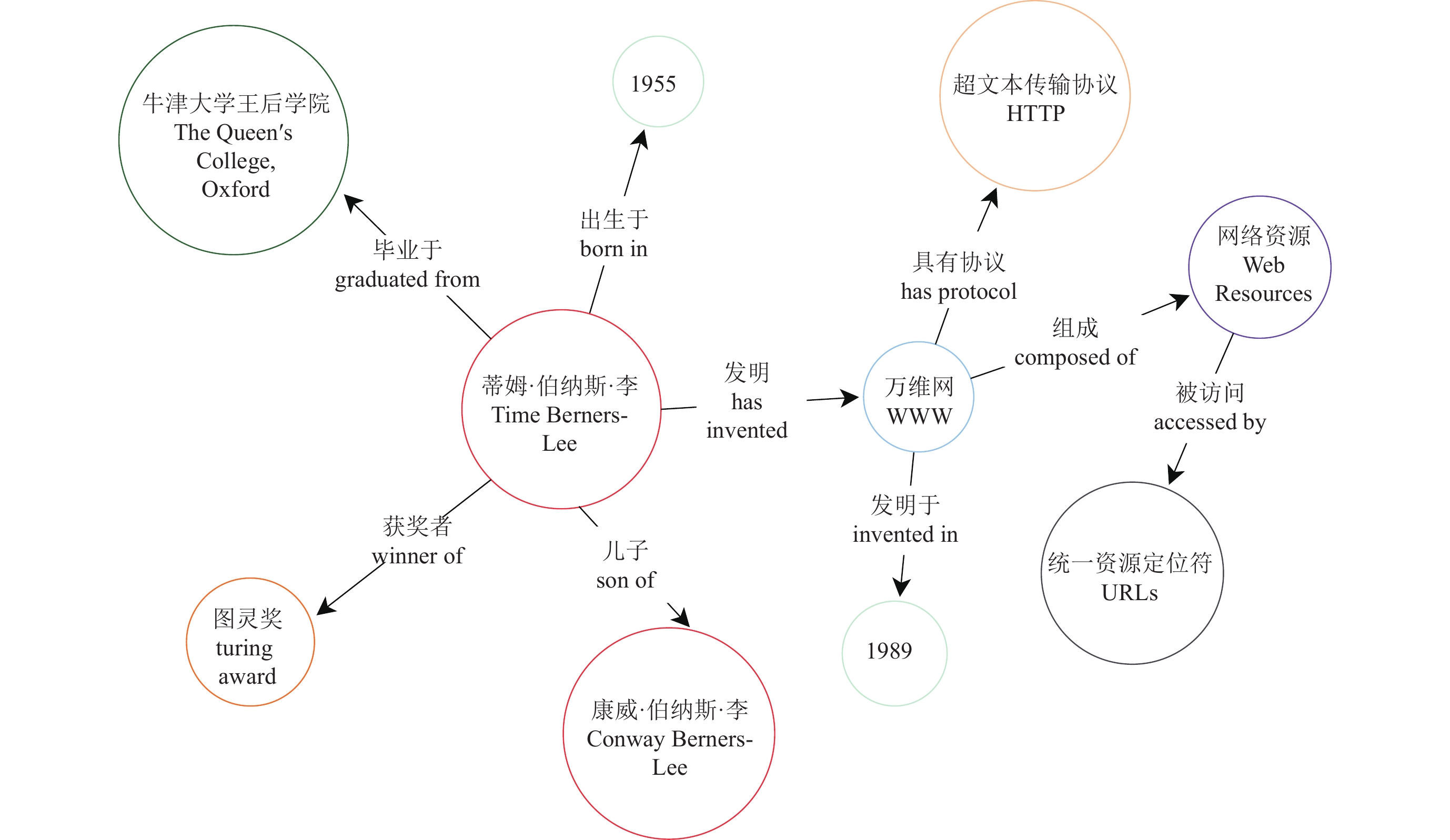
 下载:
下载:
